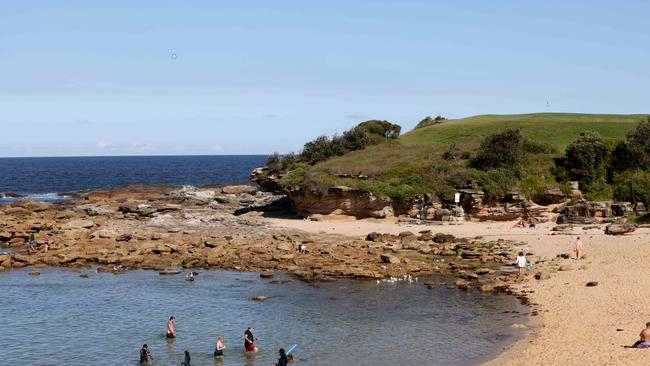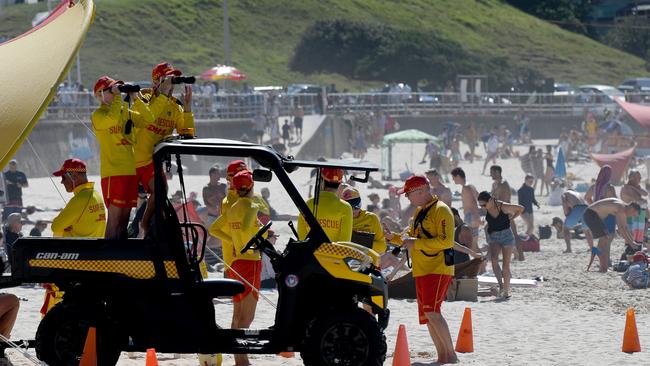NSW’s deadliest beach drowning hot spots: Randwick, Northern Beaches Central Coast top list
The state’s deadliest coastlines have been revealed in shock death toll data, as the wife and mother of a father and son killed last week calls for more safety measures at a drowning hotspot.
Local
Don't miss out on the headlines from Local. Followed categories will be added to My News.
The state’s deadliest swimming spots have been revealed in shocking new death toll data — as a heartbroken mother, forced to watch her husband and son drown in a rock fishing incident, has called for a Sydney council to install lifeguards at an unpatrolled beach.
Hills resident Sara watched on as her 10-year-old son Mahan and husband Peter drowned shortly after being swept off the rocks at Little Bay on January 31.

The bereaved parent said she lost her “entire world in the blink of an eye” in an incident, she believes, could have been prevented by more warning and lifeguard patrols.
Sara said Randwick Council should install lifeguards at Little Bay in an effort to “ensure this never happens to another family”.
Drowning death toll data, released exclusively to NewsLocal, reveals the Randwick LGA — where Little Bay is located — is the coastal drowning capital of NSW with 34 deaths in the ten years to 2021.

The Northern Beaches LGA follows with 33 deaths in the same period, followed by the Central Coast (32), Coffs Harbour (32) and Sutherland Shire (29).
In the Randwick LGA there were a massive 51 coastal drownings from 2004 to 2021, with 17 attributed to rock fishing, while a further 12 died while swimming.
Surf Life Saving NSW’s operations manager Brent Manieri said the high number of drownings along the ten most deadly beaches was concerning — which is why the organisation has 20,000 lifesavers patrolling NSW coastlines each year.
Asked if the most dangerous spots should be patrolled more heavily, he said it was not feasible to have Life Guards on each of NSW’s 700 beaches.
“Rock-fishing accounts for just four per cent of water activities at NSW beaches but makes up 14% of drowning deaths,” he said.
Mr Manieri acknowledged the over representation needed to be addressed but said banning the sport was not a solution, “even in the most dangerous spots such as Little Bay”
Deciding where Life Guards patrol was “based on risk assessment”, he said, but specifically on the risk of drownings from activities such as swimming and boating as opposed to rock-fishing.
“Life saving does not provide services on rock surfaces where many of these deaths have occurred,” he said. “That’s why we’ve been expanding our support operation networks beyond the flag services you see along the NSW coast line and they are provided by jet ski patrols, UAV (drone) patrols, providing up-to-date intel back to patrols.

“NSW is implementing emergency response beacons at high risk locations and looking to work and utilise camera networks to remotely surveil. But in regards to provision of services along rocks, at the end of the day, local government decides where to patrol.”
Mr Manieri said there was no emergency beacon installed at Little Bay, but in place in 60 other high-risk locations across NSW and the team is “always looking to review and expand to areas that have a number of incidents occurring”.
Asked what could be done to make the most deadly spots safer, Mr Manieri said it came down to personal responsibility and asked people to wear life jackets, research whether certain spots are dangerous before visiting and check water and weather conditions.
The Surf Lifesaving boss also highlighted how the beaches in the Local Government Areas with the most drownings are some of the most visited in NSW and they are not necessarily the most dangerous on a per visitor basis.
SEE THE LGAs WITH THE HIGHEST NUMBER OF DROWNINGS HERE
A Randwick Council spokeswoman expressed their condolences and sympathies following the death at Little Bay on January 31.
“Nobody should have to go through the agony of losing loved ones undertaking what should be a fun activity,” she said.
“As a result of this terrible tragedy, we are undertaking a review of the education and communication to rock fishers along the Randwick City coastline. This includes looking at signage, enforcement of lifejacket rules, practical safety training as well as a review of the provision of Lifeguard and lifesaving services along the Randwick City coastline.
“Randwick Council was the first council to introduce compulsory lifejacket laws for rock fishers back in 2016 and we’ve got extensive signage along our coastline about the dangers of rock fishing and the need to wear a lifejacket. But clearly more can always be done and we’ll be looking at all options to improve safety for rock fishers.”




